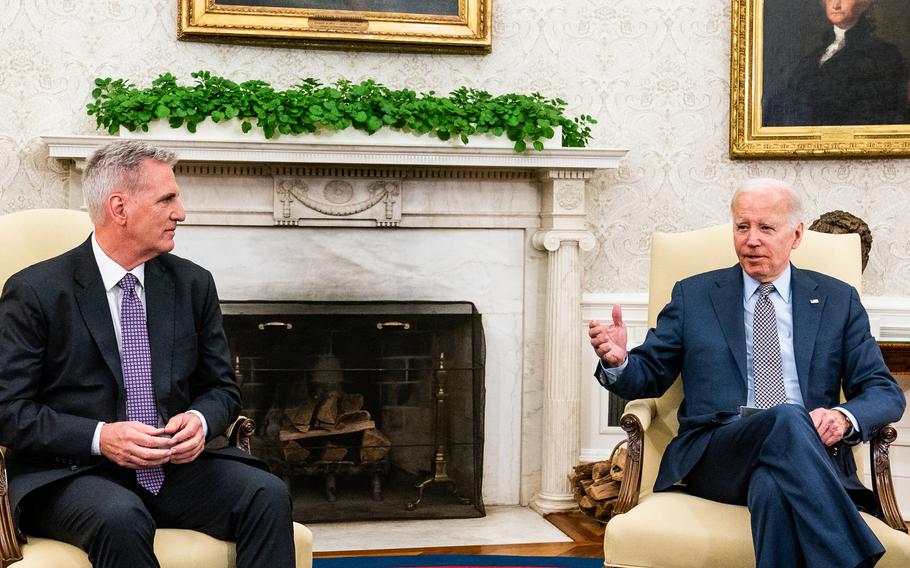
President Biden meets with House Speaker Kevin McCarthy (R-Calif.) in the Oval Office of the White House in Washington, D.C., on May 22, 2023. (Demetrius Freeman/The Washington Post)
The U.S. debt is expected to soar to historic levels over the next 30 years, eventually reaching 181% of the country’s total economic output — even after Republicans drove a high-stakes standoff this spring to secure what they described as a major improvement in the nation’s fiscal health.
A new forecast Wednesday from the Congressional Budget Office, the nonpartisan spending scorekeeper on Capitol Hill, described the government’s long-term finances as slightly improved yet still “challenging,” and it raised the prospect that the bleak outlook could create a future drag on the U.S. economy.
Over the next 30 years, the annual shortfall between what Washington spends on federal programs and collects in tax revenue — the gap is known as the deficit — is expected to fall as a share of the economy by 2027, then begin growing again, and by 2053 reaching levels not seen since World War II.
The yearly deficit adds to the federal debt held by the public, and the CBO expects the debt to reach 107% of the country’s gross domestic product, a measure of economic output, by 2029 — surpassing its historical high. The debt is expected to continue to grow as a share of GDP to 181% by 2053.
The predictions reflect a host of assumptions about the strength of the U.S. economy, uncertainty about interest rates, the state of the labor force and the government’s ongoing fight to curb inflation. They also amount to a meager upgrade from the CBO’s last forecast, issued in July 2022, which the watchdog attributed in part to the adoption of the Fiscal Responsibility Act. The deal, reached between President Biden and House Speaker Kevin McCarthy (R-Calif.), limits federal spending in exchange for suspending the debt ceiling until 2025.
But the CBO still raised “significant risks” to the country’s long-term fiscal climate while cautioning that its predictions hinge on Congress’s carrying out current law as written. Even now, though, lawmakers openly admit that they hope to flout the spending caps they just passed — with Republicans already angling to boost defense and Democrats eager to plus-up health, education and welfare programs.
GOP leaders, meanwhile, have made clear they hope to extend a set of tax cuts for businesses and individuals that they first secured under President Donald Trump in 2017. Those tax cuts are supposed to start expiring in two years, contributing to what the CBO described as a “significant source” of new federal revenue growth in the coming decades — unless lawmakers opt to put them back in place.
Taken together, the CBO report underscores the complicated calculations on the horizon for U.S. policymakers, who must grapple with the reality that any significant improvement in the nation’s finances could come at the cost of their own agendas.
Generally, budget hawks see a stubbornly high federal debt as a drag on the economy and a threat to the government’s fiscal health and to national security. In its report, the CBO warned that an imbalance that consistently exceeds the country’s yearly output could slow future growth while making it more expensive for the United States to service debt it owes to foreign entities. Other experts, however, take a less rigid view, arguing in part that extreme efforts to cut costs also could hurt the economy and workers.
Nevertheless, Republicans took control of the House this January and immediately embarked on an effort to slash federal spending by hundreds of billions of dollars. For months, McCarthy and his allies held up an effort to raise the debt ceiling — the legal maximum the country can borrow to pay its bills — in a bid to force Biden to accept huge spending reductions. The move brought the government within days of its first default, which could have tipped the economy into a recession.
The resulting agreement, enacted in June, largely preserved spending at its existing levels, capping agencies’ future budgets at 1% percent growth through 2025. McCarthy and Biden also agreed to a set of nonbinding spending targets for the remainder of the decade, which could contribute to a total $1.5 trillion of savings under the law, if Congress sticks to the agreement.
In its forecast Wednesday, the CBO attributed some of the country’s constant fiscal woes to “persistently large” deficits, which could cause interest costs to blossom as well. The country also faces rising health-care and retirement costs that are due to an aging population, two issues that Democrats and Republicans did not address as part of the recent spending deal.
But the CBO noted that the government’s retirement programs — Social Security and Medicare — still face the fast-approaching prospect of insolvency unless Congress rethinks the way they are paid for or cuts benefits. The trust funds for seniors’ retirement benefits and hospital care could be exhausted by 2032 and 2035, respectively, the CBO warned anew.